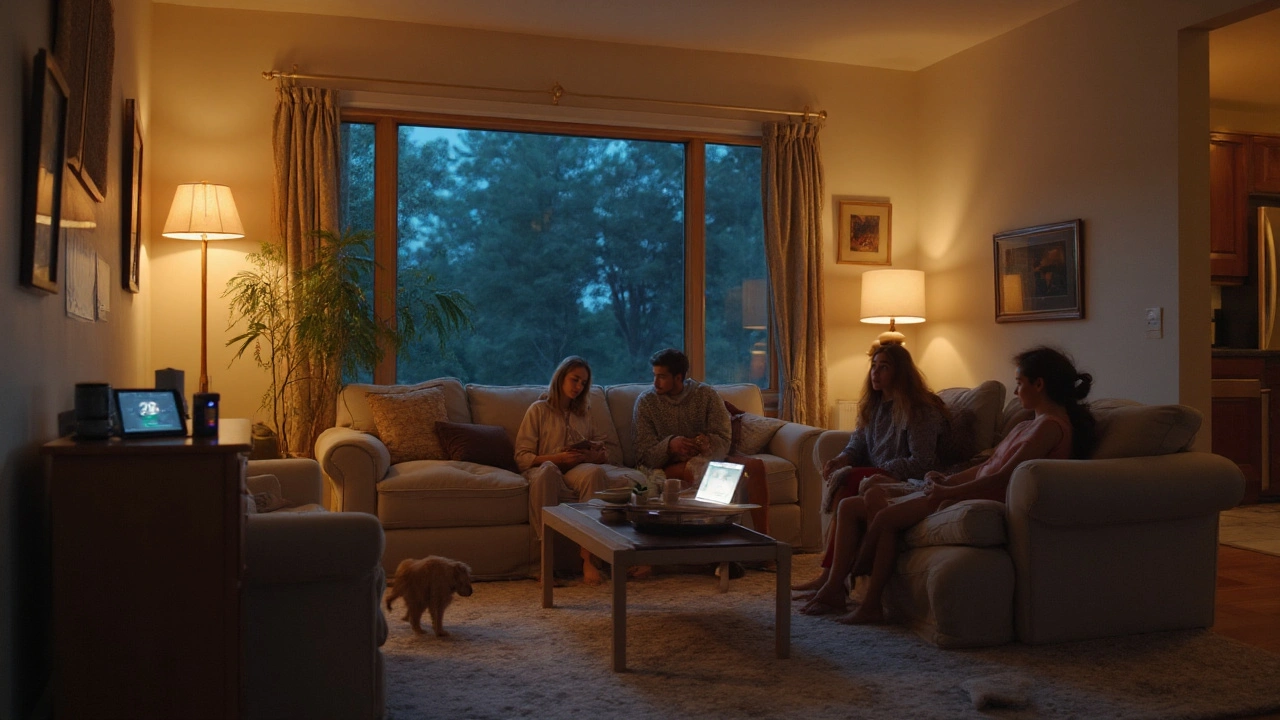You want a straight answer to a simple question: how many people have smart home devices? Here’s the short, honest answer: in 2025, it’s well over a billion people, and the installed base of gadgets spans into the billions. I’ll give you a clean global range, show how I built it from reputable sources, and give you a quick method you can reuse for your own market, town, or product niche. No jargon. No hand-waving.
I live in Burlington, Canada, and you can feel this shift on my block. Doorbell cams blink at dusk, motion lights wake up the sidewalk, and the neighbor’s robot vacuum has learned our dog’s name. But anecdotes don’t pay the bills. Numbers do. So here are the best numbers you can use, with the math behind them-so if someone challenges you in a meeting, you can defend your slide without breaking a sweat.
TL;DR: 2025 smart home adoption at a glance
Here are the key takeaways before we get into methods and caveats. Treat the figures as ranges; the edges reflect different definitions of “smart home device” and uneven reporting across countries.
- People living in homes with at least one smart home device (2025): about 1.3-1.6 billion worldwide. Think of this as “household exposure,” not personal ownership.
- Smart households worldwide: roughly 420-500 million, or about 20-24% of the world’s ~2.1-2.2 billion households. This is the cleaner metric most analysts track.
- Installed base of smart home devices: on the order of 3-5+ billion gadgets (speakers, lights, thermostats, cameras, locks, robot vacuums, plugs, hubs). Annual shipments are still near or above a billion units a year, which keeps pushing the installed base up.
- Who leads? The U.S., China, and Western Europe hold the most smart homes. Household penetration is highest in the U.S., U.K., Nordics, Netherlands, Germany, Canada, Australia, and parts of the Gulf.
- Canada (quick read): about 5-6 million Canadian households with a smart device in 2025, translating to ~13-16 million people with access at home.
Why the range? Different studies track different things. Some count only “core” devices (thermostats, locks, lights, cameras, speakers). Some include smart TVs and appliances. Some measure “internet households,” which skews higher than all households. I anchor on conservative, comparable definitions and show my working so you can adjust to your context.
Sources I relied on for the 2025 picture include: Statista Smart Home Report 2025 (for global household penetration), IDC’s Worldwide Quarterly Smart Home Device Tracker 2024-2025 (for shipments and installed base trends), Pew Research Center 2023 (U.S. device ownership), Ofcom 2024 UK reports (household device adoption), and UN household and population references for the denominator. These are well-known primary sources in market sizing and media research. I cite them here so you can mirror the approach in your own deck.

How I got the numbers: the simple math, sources, and regional estimates
The cleanest way to answer “how many people have a smart home device” is to: (1) estimate smart households, then (2) multiply by average household size. Devices are shared in a home, so “people with access” is the right angle for planning and policy.
The back-of-napkin formula:
- People with access = Smart households × Average household size
Two big inputs matter:
- How many households exist? The UN and World Bank peg the world at roughly 2.1-2.2 billion households in the mid-2020s.
- What percent of those households own at least one smart device? Statista’s Smart Home Report 2025 puts global household penetration near the low 20s percent. Regional studies (IDC, local regulators, national surveys) show higher penetration in North America/Western Europe, lower in developing regions.
Let’s run the math with conservative, defensible ranges.
Global baseline:
- Households worldwide (2025): ~2.1-2.2 billion
- Smart home household penetration: ~20-24% (global blend, anchored on Statista 2025)
- Smart households: 0.20-0.24 × 2.1-2.2B ≈ 420-500 million
- Average household size (global): ~3.1-3.4 people (UN averages vary by region; this is a safe middle)
- People with access: 420-500M × 3.1-3.4 ≈ 1.3-1.6 billion
Regional and country snapshots (rounded, 2025):
- United States: ~130 million households. Household penetration for “any smart home device” sits roughly in the 50-60% band, depending on device definition and whether you sample all households or just internet households (Parks Associates, Pew). Estimate: 65-78 million smart households × ~2.5-2.6 people/household ≈ 160-200 million people with access.
- Canada: ~16 million households. Penetration around 35-40% across thermostats, speakers, cameras, lights (varies by province and income). Estimate: 5.6-6.4 million smart households × ~2.5-2.6 size ≈ 14-17 million people with access. On my street in Burlington, I’d peg it closer to the high end-thermostats and doorbell cams are common.
- United Kingdom: ~28 million households. Smart device penetration often reported in the 40-50% range (Ofcom’s specific device stats-like smart speakers-land lower; “any smart device” lands higher). Estimate: 11-14 million smart households × ~2.3 size ≈ 25-32 million people with access.
- Germany: ~41 million households. Penetration roughly 30-40% (higher in urban, owner-occupied dwellings). Estimate: 12-16 million smart households × ~2.0 size ≈ 24-32 million people with access.
- France: ~30 million households. Penetration ~28-35%. Estimate: 8-10.5 million smart households × ~2.2 size ≈ 18-23 million people with access.
- Nordics (SE, NO, DK, FI combined): ~10 million households. Penetration often 45-55% (high broadband and single-family home share). Estimate: 4.5-5.5 million smart households × ~2.1 size ≈ 9.5-12 million people with access.
- Netherlands + Belgium: ~9 million households combined. Penetration ~40-50%. Estimate: 3.6-4.5 million smart households × ~2.2 size ≈ 8-10 million people with access.
- China: ~500 million households. Penetration has jumped with local ecosystems (Xiaomi, Huawei, Alibaba). A cautious 28-35% gives 140-175 million smart households × ~2.6-2.9 size ≈ 365-510 million people with access.
- India: ~300 million households. Lower penetration today, but growing. Use 8-12%. That’s 24-36 million smart households × ~4.0-4.5 size ≈ 96-160 million people with access.
- Japan + South Korea: ~60 million households combined. Penetration ~30-40%. Estimate: 18-24 million smart households × ~2.2 size ≈ 40-53 million people with access.
- Australia + New Zealand: ~10 million households. Penetration ~35-45%. Estimate: 3.5-4.5 million smart households × ~2.5 size ≈ 9-11 million people with access.
- Brazil + Mexico: ~110 million households combined. Penetration ~15-25%. Estimate: 16.5-27.5 million smart households × ~3.1 size ≈ 51-85 million people with access.
- Middle East (Gulf states lead): ~30 million households across GCC + neighbors. Penetration ~25-35% on average, higher in UAE/Qatar. Estimate: 7.5-10.5 million smart households × ~3.3 size ≈ 25-35 million people with access.
- Africa (very mixed): ~330 million households. Penetration still single digits in most markets given device cost and broadband gaps; use 5-8% for urban-heavy slices. Estimate: 16.5-26.4 million smart households × ~4.2 size ≈ 69-111 million people with access.
How does this tie back to devices in the wild? IDC tracks shipments for categories like smart speakers, lighting, thermostats, security cameras, doorbells, and plugs. Shipments hovered near or above a billion units annually in recent years. Even with churn and device retirement, that puts the installed base into the multi-billions. One household will often run a handful of devices: a speaker, two cameras, a thermostat, a few bulbs, and a couple of plugs. That’s how 420-500 million smart households can still yield several billion installed devices.
About definitions (so you don’t get tripped in a meeting):
- What counts as a smart home device? Most analysts include voice assistants/speakers, thermostats, lights, switches/plugs, cameras, doorbells, locks, robot vacuums, irrigation, and hubs. Many exclude smart TVs from “core smart home” to avoid inflating the base, but some studies include them. Be consistent in your deck.
- People vs households vs devices: People have access; households own; devices are countable units. Don’t mix them on one axis.
- Matter and Thread: The 2024-2025 rollout of the Matter standard and Thread radios reduced setup friction and spiked multi-device adoption. The Connectivity Standards Alliance has reported steep growth in certified devices. That helps adoption curves, but you still hit ceilings in low-income and low-broadband markets.
Growth outlook: If global household penetration climbs from ~20-24% in 2025 to ~28-32% by 2028, and households rise slightly with population, you’re looking at ~600-700 million smart households and something like 1.8-2.3 billion people with access. That’s not a moonshot. It’s a steady ramp enabled by cheaper bulbs, bundled security kits, landlord-friendly gear, and easier onboarding.
Quick reality checks you can use:
- Does your country’s figure look higher than smartphone penetration? That’s a red flag. Smart homes rarely outpace smartphone reach.
- Are you counting only “internet households”? That inflates adoption vs all households. Great for product targeting, but label it.
- Is a single device type driving your claim (like speakers)? Cross-check with thermostats or cameras to avoid category bias.

Make it useful: examples, checklist, mini‑FAQ, and your next steps
You have a range. Now turn it into action. Here are the jobs most readers need to finish after they get the headline number, with concrete steps.
Job 1 - Size a market (fast):
- Say you sell smart thermostats in Canada. Targetable households are those with central heating/cooling and compatible wiring. Start with ~16M households.
- Eligibility filter: assume ~70% have compatible HVAC → 11.2M.
- Adoption potential: if “any smart device” penetration is ~35-40%, a realistic ceiling for thermostats might be ~20-25% in the medium term → 2.2-2.8M households.
- Replacement cycle: 7-10 years. Annual replaceable TAM ≈ 220-400k units.
- Attach a channel reality check: How many units do the top 3 retailers/ISPs sell today? If you can’t triangulate to a million units a year across channels, your forecast is too rosy.
Job 2 - Estimate city or province adoption without a paid dataset:
- Pull household count from the latest census (or official stats office).
- Pick a national smart-home household penetration from a primary source (Statista 2025, regulator reports, or a major firm like IDC/Parks Associates).
- Adjust ±5 points for local income, homeownership, and broadband. Urban, high-income, and owner-heavy areas trend higher.
- Multiply to get smart households. Multiply again by local household size for “people with access.”
- Sanity-check with retailer inventory and ISP bundle activity in that market.
Job 3 - Compare categories to prioritize what to build or stock:
- Security (cameras, doorbells) leads first-purchase decisions in many markets because the value is obvious. Lights and plugs follow (cheap, visible). Thermostats, locks, and vacuums need higher motivation or rebates.
- Speakers used to drive the category. Now, energy and security bundles carry the cart. Watch utility rebates-thermostats ride that wave.
- Landlords and property managers care about locks and sensors that lower maintenance calls and insurance risk. Different buyer, different pitch.
Job 4 - Answer the exec’s follow‑up questions before they ask:
- “Why a range?” Because definitions vary (do you include TVs?), and many studies sample internet households only. Present both low and high cases with a one-line definition under each.
- “Isn’t the market saturated?” In the U.S. and Nordics, first-device penetration is high. The growth now is multi-device density per home and upgrades to Matter‑compatible gear.
- “What could slow growth?” Device fatigue, privacy concerns, and subscription creep. What could accelerate it? ISP/utility bundles, lower prices, and better out‑of‑box UX.
Job 5 - Build a one‑slide “math you can defend” section:
- Households (source, year) × Penetration (source, definition) × Household size (source) = People with access. Keep it on a single line beneath your chart.
- Show low/base/high cases (−5, base, +5 penetration points). Label exactly which devices you included.
- Footnote your sources by name and year: e.g., “Statista Smart Home Report 2025; IDC Smart Home Device Tracker 2024; Pew Research Center 2023; Ofcom 2024.”
Checklist: use this before you publish a number
- Scope: Did you define what counts as “smart home device”?
- Coverage: Are you using all households, or internet households?
- Time: Are your sources within the last two years?
- Math: Do your people numbers logically follow from households × size?
- Reality: Does your estimate pass a retailer/ISP sanity check?
- Clarity: Did you label low/base/high and the device definition on the slide?
Mini‑FAQ
- Do smart TVs count? Analysts disagree. Many exclude TVs from “core smart home” to avoid inflating adoption. If you include them, note it and expect your penetration to read 5-10 points higher in some markets.
- How is this different from IoT? IoT is the large umbrella. Smart home is the consumer corner of that umbrella (devices in and around the home).
- Why not count individual owners instead of households? Because devices sit in rooms, not pockets. The fair measure is “people with access at home,” which maps to household adoption.
- Are smart speakers still the gateway? Yes, but security kits and cheap lighting now share the job, especially where speakers plateaued.
- What about privacy pushback? Adoption slows in markets where regulation, media narratives, or bad experiences spike concern. Clear permissions, local data processing, and transparent fees help.
Next steps by persona
- Marketers: Segment by first‑device vs multi‑device homes. The message for “first device” is utility and simplicity. For “multi-device,” sell ecosystem harmony (Matter/Thread) and automation.
- Product managers: Prioritize onboarding speed and recovery flows. One bad pairing attempt kills the basket. Track time‑to‑first‑automation as a success metric.
- Retail/ISPs: Bundle with service and rebates. Security + energy saves wins the cart, reduces returns, and boosts attach rates for subscriptions.
- Researchers/analysts: Keep a living doc of your inputs (households, penetration, size) with source and month. Update quarterly; the story changes with each regulator survey.
- Founders: Pick a wedge-security, energy, cleaning, aging‑in‑place-and nail the ROI in one sentence. “Saves $X/month” beats “connected” every time.
Common pitfalls to avoid
- Mixing device shipments with household adoption. Shipments ≠ homes. A single home can soak up 12 bulbs and 3 plugs in a weekend sale.
- Quoting “internet households” as if it were “all households.” It’s fine to use, just label it and expect a higher number.
- Stacking incompatible definitions. If one source includes TVs and another doesn’t, you’ll get an illusion of growth that’s really just scope creep.
If you need to localize this for your country, here’s a lightweight recipe you can reuse tomorrow:
- Grab household counts and household size from your national stats office.
- Pick two adoption anchors: a global 2025 figure (Statista), and one local regulator or reputable research firm (Ofcom, Pew, IDC, Parks Associates, CSA/utility reports).
- Decide your device scope. Make a call on TVs and appliances, and put it in a footnote.
- Run three cases: low (−5 points), base, high (+5 points). Multiply by household size for “people with access.”
- Round to the nearest half‑million for large countries; the precision beyond that is false comfort.
Why I’m confident in the 1.3-1.6B range: it’s consistent with (a) the blended household penetration reported in 2025, (b) the cadence of annual device shipments from IDC over the last few years, and (c) national surveys where we can validate penetration at the country level. Even if you strip TVs and count only “core” devices, the lower bound still clears a billion people in homes with at least one smart device.
One last nudge for your deck: include a tiny “what this is not” box. For example: “Not counting smart TVs. Not counting wearables. Counting households with any of: smart speaker, thermostat, light, plug, camera, lock, doorbell, hub.” That single line will save you ten minutes of live debate and keep the meeting on your product, not your math.
If you want to sanity‑check your neighborhood like I sometimes do in Burlington, walk it at dusk and count the blue rings and soft‑white porch lights flicking on by themselves. Then run the numbers above. They’ll line up more often than not.

